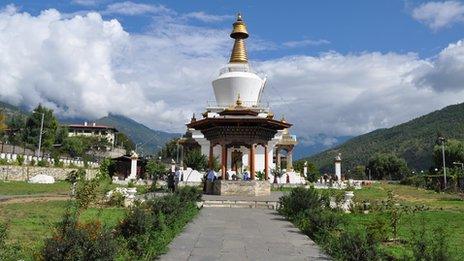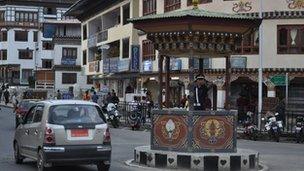Reality hits charming Bhutan
- Published

Bhutan must decide whether to allow more tourism in order to boost growth
A land of pristine natural beauty and spectacular scenery, Bhutan is a dream tourist destination.
Visitors from far and wide marvel at its lush green mountains and silvery snow peaks together with the centuries-old fortresses and monasteries dotted across this Himalayan nation.
The citizens of Bhutan are regarded as being among the happiest in the world.
The country measures the quality of life of its people by their happiness, widely known as Gross National Happiness (GNH), rather than by its Gross National Product (GNP), striking a balance between the spiritual and material.
Bhutan remained relatively isolated until the 1970s.
Although the internet and television were allowed into the country only in 1999, the Bhutanese, particularly the youth, seem to have taken to such modernisations with ease.
The people are very active in social media, wear trendy clothes, use smartphones, drive the latest cars and go to karoke bars in the evenings.
There is also a construction boom in big cities such as the capital, Thimphu, as the demand to buy a house or flat increases.
But as modernity and consumerism take hold in the Himalayan nation, Bhutan is facing a host of problems, including poverty, youth unemployment, and growing public debt.
'Rein in excesses'
Bhutan's youth unemployment is around 7.3%, and its external debt has soared to nearly 90% of its Gross Domestic Product (GDP).
The Bhutanese Prime Minister, Tshering Tobgay, says it is time for Bhutan to face up to the reality.
"We have to admit that there is a problem. (We must) rein in the excesses of the government and the people and get down to the hard work of producing goods for ourselves and to export. There is no shortcut to economic growth," Mr Tobgay tells the BBC.
Following a sharp increase in public debt, the authorities have restricted bank loans for houses and cars. As a result, car imports, mostly from neighbouring India, have nearly come to a halt.
Bhutan, which has a population of around 730,000, earns most of its revenue from exports of electricity to India and also from tourism.
Last year a record 100,000 tourists (both international and regional) visited Bhutan bringing in revenue of more than $227m (£141m), the second highest earning sector after exports of hydro power to India.
Some people argue more tourists should be allowed into the country to boost employment and revenue.

Chhimmy Pen says mass tourism would be wrong for Bhutan
Currently, international visitors from outside the South Asian region have to pay $250 (£155) a day for their visit in advance. The fee includes accommodation, travel and food.
Pragmatic
If those strict controls were relaxed, some say, mass tourism could bring in much needed cash. But the authorities are cautious.
"Our tourism policy has always been high value and low impact. The policy we have followed so far has served us well. We feel that environmentally, culturally and sustainability-wise we cannot afford to have mass tourism in Bhutan," says Chhimmy Pem, head of marketing at the Tourism Council of Bhutan.
Many western tourists feel that Bhutan is a magical place and it should retain its exclusivity.
"I think Bhutan shouldn't allow mass tourism. We have seen what mass tourism has done to other places. So, it should keep the policy of restricting tourists. Otherwise this special place will lose its charm," says Manuel Doemer, a tourist from Switzerland.
However, Bhutan's options are limited. It does not have many products in its export basket. Some people feel that sooner or later the government will have to review its policy.
Tour operators such as Sonam Dorji argue that if Bhutan decides to have more tourists, it does not have the infrastructure to meet the expected influx.
"The most important thing would be improving the access - air access and road access. At the moment, only one airline is flying into Bhutan. Besides that, accommodation is still lacking in central and eastern Bhutan," says Mr Dorji, executive director of Association of Bhutanese Tour operators.

As Bhutan modernises, the demand for homes and cars is growing
He also points out that internet coverage, the speed and the bandwidth, is quite limited in certain areas of the country and acceptance of credit cards is also not widespread.
But, with a growing population, officials realise it will be difficult to generate employment for the youth and they have to be pragmatic.
"Our challenge is to increase the number of tourist arrivals, but to spread them throughout the year and throughout the country. So that we don't have tourists bumping into each other," says the prime minister.
The reality is in the long-term, the country needs more money.
And it will be a challenge for the authorities to keep limiting the number of tourists they let in.
- Published20 October 2013
- Published17 October 2013
- Published2 August 2013